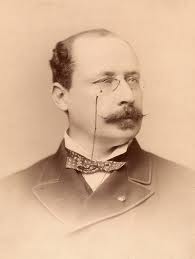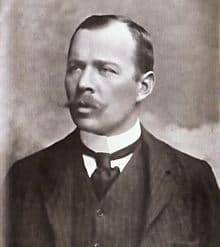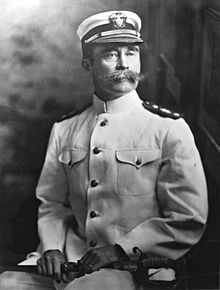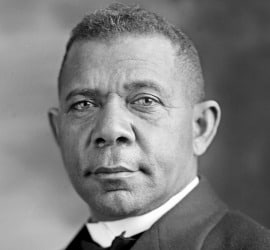On October 14, 1895, a local news item announced that a lecture bureau out East had arranged for a lecture speaking tour. Lew Wallace was named as one of the important people to be a part of this tour. The tour was unusual because of the diversity of the assembled speakers. In addition to Lew Wallace, the speakers included Max O’Rell, C.E. Borchgrevick, and Robert E. Peary. Each of these men was considered a “hot topic” of the day. The diversity came with the two others named to the tour—a woman, Rose G. Kingsley and an African American, Booker T. Washington. The details of the tour are not specified, but it is clear Lew Wallace was a highly sought after speaker to be included with this group.
Max O’Rell

Max O’Rell was born Leon Pierre Blouet in Normandy in 1847. He moved to Paris at the age of 12 and eventually graduated from the conservatoire and the collège in Paris and went on to take a B.A. degree in 1865 and a B.Sc. in 1866 at the Sorbonne. After 1866, he enrolled at the École Militaire which he left in 1869 with the rank of lieutenant in the French artillery, spending five months in Algeria and, after a short stay in the Versailles garrison, was called up to fight in the Franco-Prussian War. Wallace surely would have found this military career fascinating.
Blouet left France and secured a position teaching French at the prestigious St. Paul’s London boys’ school. Like Lew Wallace, he wrote on the side, but unlike Lew he published his works under a pseudonym in an effort to protect his teaching position. He published a book of sketches and observations about England under the name Max O’Rell that gave an overview of English customs, peculiarities, and institutions. He discussed everything from British colonial ambitions to the Anglo-Saxon concept of home. His book went through 57 editions within two years, eventually selling 275,000 copies in England and over 200,000 in America.
In 1885, he resigned his teaching post and began working full time as an author and lecturer. In seven lecture tours—including the one announced in 1895, he spoke over 2,600 times. Earlier in 1895, O’Rell and Mark Twain had a heated exchange about French morals that the world press documented even hinting at a physical altercation between the two men. Although he fell out of the limelight later in life, to American and British audiences, O’Rell served as a reference for everything French and he had great impact on public discussions of political, social and cultural matters. He continues to be of particular interest to cultural historians studying the presentation of gender roles.
C.B. Borchgrevink

C.E. Borchgrevick was a famed Anglo-Norwegian explorer of the Antarctic. At the time of the 1895 announcement he had just returned from a Norwegian whaling expedition, from which he brought back a collection of the first specimens of vegetable life from within the Antarctic Circle. Like Lew Wallace, Borchgrevick was child with a restless nature and a passion for adventure. Born in Norway, he studied forestry in Germany and worked in Australia for four years, where he became interested in polar exploration. His first expedition to Antarctica came in 1894. On August 1, 1895 just weeks before he was hired for the lecture circuit, he addressed the Royal Geographical Society in London announcing plans to develop a research station that would overwinter in Antarctica. His enthusiastic but brusque presentation did not result in financial support from the Royal Geographical Society so he used the 1895 lecture circuit to raise both awareness of and funding for continued polar expeditions. He continued his explorations for years including some to the Caribbean for the National Geographic Society.
Robert Peary

Perhaps to balance Borchgrevick and Antarctica, the 1895 selection of speakers included Robert Peary who was an explorer at the other end of the world. Peary’s explorations that would ultimately take him to the North Pole in 1909 began in the mid-1880s with trips over Greenland’s ice caps in an effort to determine whether or not Greenland was an island. His explorations captured the public imagination throughout the 1890s and turn of the twentieth century.
Rose G. Kingsley
Rose G. Kingsley (no image available) was famous first as the daughter of the Reverend Charles Kingsley, Canon of Westminster in the 1870s and widely known at the time as a professor, historian and novelist. Perhaps his most famous work was a tale about a chimney sweep entitled The Water-Babies, A Fairy Tale for a Land Baby (1863). Retaining its popularity well into the 20th century, the story demonstrated his concern for social reform and dealt with the scientific debate over human origins, as Kingsley was one of the first influential religious leaders to embrace Charles Darwin’s theory of evolution. With a curious and learned father, it was no surprise that Rose Kingsley was an adventurous spirit.
Rose moved from England to Colorado Springs in 1871, just one year after it was founded. For a young woman raised in affluence, life on the frontier was challenging, but Rose soon helped establish the Fountain Colony Club for natural sciences which served as a vehicle to counter some of the rougher elements on the frontier. She soon began her own writing career with her book South and West which was published in London in 1874 and detailed her experiences in Colorado and New Mexico. The book was illustrated with sketches of local scenes drawn by Rose and hers are the first sketches made of Colorado Springs. By the 1890s, Rose was gaining notice for her books on nature and gardening.
Booker T. Washington
The final speaker listed in the 1895 lecture program was Booker T. Washington. As the newspaper notice said: “The world is moving very rapidly these days, when an eloquent and brainy negro is named in the same list with eloquent and brainy white men as platform favorites.” Washington was born into slavery but went on to become an educator, author, fund-raiser, orator, and advisor to Republican presidents. As the first leader of Tuskegee Normal & Industrial Institute, he became the dominant leader in the African-American community in the United States from 1890 until his death in 1915.

Although much respected and admired, Washington was not without controversy. In October 1895, when he was included in the lecture bureau, he was in the news for his Atlanta Exposition speech delivered at the Atlanta Cotton States and International Exposition. This speech, delivered just four weeks earlier in September, was viewed as a revolutionary presentation at the time it was delivered. Although the Exposition was opened by President Grover Cleveland, it was and still is best remembered for Washington’s speech.
Washington on the Speaking Tour
In this speech he advocated a “go slow” approach to integration to avoid a white backlash and emphasized the need for blacks to concentrate all their energies on industrial education, accumulation of wealth, and conciliation with the leadership of the South. He thought these skills would lay the foundation for the creation of stability that the African-American community required in order to move forward. He believed that in the long term “blacks would eventually gain full participation in society by showing themselves to be responsible, reliable American citizens.” His approach advocated for an initial step toward equal rights, rather than full equality under the law. Ultimately this philosophy would put him at odds with many in the black community who felt disenfranchised and placed in subordinate roles in society.
Each of these speakers announced in the 1895 lecture tour was either at or approaching the pinnacles of their respective careers. Their names were widely known and their topics would have been of great interest. Given his broad personal interests Wallace would have certainly appreciated the opportunity to travel with and privately discuss the pressing issues of the day with this distinguished group. While Wallace was widely recognized as a gifted speaker, it is intriguing to wonder if sharing the stage with some of these other gifted orators inspired him to install the roll-out full length mirror in his Study that was under construction in 1895, so that he could practice his speeches and refine his presentations.